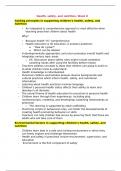Health, safety, and nutrition- Week 8
Guiding principles in supporting children’s health, safety, and
nutrition
- An integrated & comprehensive approach is most effective when
teaching preschool children about health
Why?
- Because health “IS” comprehensive
- Health education is till education, it answers questions
o “How do I grow?”
o Which can be related
- A developmentally appropriate curriculum promotes overall health and
integrates various topic areas
o EX: Discussion about safety rules might include sanitation
(washing hands after using the facilities before meals)
- Teachers address concepts & ideas that children can grasp & build on
to what children know & understand
- Health knowledge is individualized
- Preschool children and families possess diverse backgrounds and
cultural practices which inform health, safety, and nutritional
information
- Learning about health practices involves language
- Children’s personal health status affects their ability to learn and
develop in all domains
- The overall theme of health education for preschool is personal health
- Children learn through their experiences, including play,
routines/scripts, modeling, and developing/ sustaining relationships at
preschool
o This learning is supported by adult scaffolding
- Practicing scripts or behavioral rules, can foster the developmental of
creating health promoting behaviors or skills
- Teachers can help children feel secure by assuring them that there are
adults who will take care of them
Environmental factors in supporting children’s health, safety, and
nutrition
- Children learn best in a safe and inviting environment in which they
can freely explore and challenge themselves
- Health and safety in preschool involve environment, supervision, and
education
- Environment is the first component of safety
, - proper supervision is essential
o infant (1.3 ratio)
o toddler (1:4 ratio)
o preschool (1:9 ratio
- Supervision ratios are a bit more complicated as group size also plays
a role
- Supervision ratios must be always met including: outdoor, field trips,
etc.
- establish a physical learning environment designed for children’s
initiative
- provide safe, inviting learning environments, and appropriate
supervision of children.
- Maintaining a clean, healthy, and sanitary environment. Incorporate
cleaning and sanitizing into the daily routine
- Have supplies available and accessible to promote routine health
practices
- Be creative and include a gardening space, wither indoors or outdoors,
where children can plant seeds, tend the garden, and watch the plants
grow
- Provide stimulating and developmentally appropriate materials in
interest areas for children’s use during play.
- Provide furnishing and utensils appropriate for children’s size and
abilities
- Be creative and include a gardening space, either indoors or outdoors,
where children can plant seeds, tend the garden, and watch the plants
grow
Research Highlight
- Cleaning and disinfection are essential
- Soap and water remove visible soil
- 1 TBSP bleach + 1 quart of water = disinfecting
solution
o Wet surface & air dry
o Remake solution everyday
Introducing the foundations
Supporting Healthy Habitats
- Learning healthy habits oftentimes first relies on children learning
scripted for healthy habits
, o Washing hands before a meal, brushing teeth before bed, etc.
- As children grow and develop knowledge/skills they begin to
understand that they are responsible for their own health
o If I don’t brush my teeth before bed, I will get cavities
o If I don’t wash my hands before eating, I could get very sick
- Teacher guided activities on health habits may be used to introduce or
focus attention on a specific topic
o BUT learning is primarily
o AND verbal/nonverbal scripts that illustrate the behavior
o (Coughing into elbows, using tissue to blow their nose, etc.)
- Children demonstrate knowledge of body parts, disease prevention and
wellness as they practice routines and develop descriptive scripts
o We wash our hands, finger, wrists
o They begin to understand more difficult concepts through
scaffolding
Here are *some* ways teachers can help support healthy habits:
- Teach children how to wash their hands.
- Practice toothbrushing skills.
- Model basic hygiene and disease prevention actions throughout the
day
o using tissue to blow nose, sneezing and coughing into their
elbows, using napkins, brushing teeth, using utensils to serve
foods, etc.
- Remind children about health practices throughout the day. Include
strategic placed visual reminders throughout the environment
- Observe children attentively. Learn what experience, knowledge, skills
and abilities each child has to determine where they are at in a
learning process
- Consider offering health screenings for children to develop familiarity
with health helpers.
- Integrate health promotion and sun safety with other topics and
domains.
- Provide visual representations of health helpers (ensure that you show
both male and females, various ethnicities, and various ages of
people).
- Enhance children’s knowledge and understanding through problem
solving (which health helper would provide assistance for different
situations.
- Model and share information each day about practices (such as
applying first aid for an injury) that support health.
- Integrate sun safety with emergency preparedness and safety.





